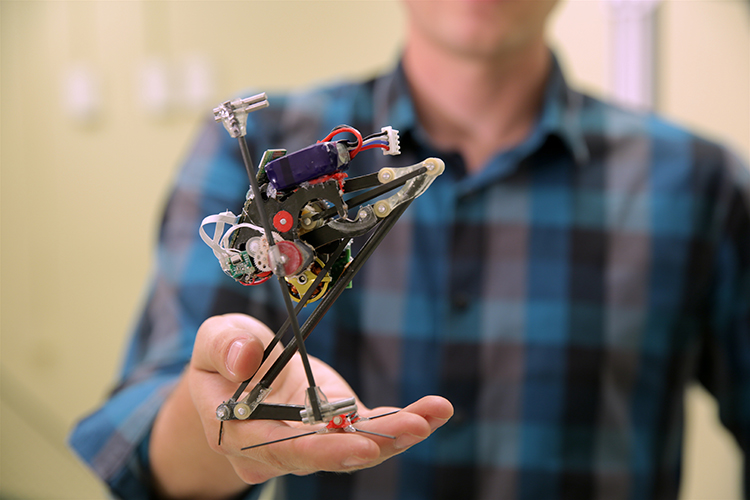Wall-jumping robot is most vertically agile ever built
Roboticists at UC Berkeley have designed a small robot that can leap into the air and then spring off a wall, or perform multiple vertical jumps in a row, resulting in the highest robotic vertical jumping agility ever recorded

December 6, 2016
Roboticists at UC Berkeley have designed a small robot that can leap into the air and then spring off a wall, or perform multiple vertical jumps in a row, resulting in the highest robotic vertical jumping agility ever recorded. The agility of the robot opens new pathways of locomotion that were not previously attainable. The researchers hope that one day this robot and other vertically agile robots can be used to jump around rubble in search and rescue missions.
To build the robot, known as Salto (for saltatorial locomotion on terrain obstacles), the engineers studied the animal kingdom’s most vertically agile creature, the galago, which can jump five times in just four seconds to gain a combined height of 8.5 meters (27.9 feet). The galago has a special ability to store energy in its tendons so that it can jump to heights not achievable by its muscles alone.
To compare the vertical agility of robots and animals, the researchers developed a new metric to measure vertical agility, defined as the height that something can reach with a single jump in Earth gravity, multiplied by the frequency at which that jump can be made. Salto’s robotic vertical jumping agility is 1.75 meters per second, which is higher than the vertical jumping agility of a bullfrog (1.71 meters per second) but short of the vertical jumping agility of the galago (2.24). The robot with the second highest vertical agility that the team measured is called Minitaur (1.1 m/s) [Watch Salto in action].
“Developing a metric to easily measure vertical agility was key to Salto’s design because it allowed us to rank animals by their jumping agility and then identify a species for inspiration,” said Duncan Haldane, a robotics Ph.D. candidate at UC Berkeley, who led the work. Haldane is a student in the Biomimetic Millisystems Lab of Ronald Fearing, a professor of electrical engineering and computer sciences.
The work will be published Dec. 6 in the debut edition of the journal Science Robotics. The research was supported by the U.S. Army Research Laboratory under the Micro Autonomous Systems and Technology Collaborative Technology Alliance, and by the National Science Foundation.
Salto’s design is based on the power modulation used by the galago. Power modulation is an adaptation found in natural systems (and designed into some robotic systems) that increases the peak power available for jumping by storing muscular energy in stretchy tendons.
The galago jumps so well because its tendons are loaded with energy by its muscles when it’s in a crouched position. Adapting this process to Salto enabled its high vertical agility, including the wall jump. Inside Salto, a motor drives a spring, which loads via a leg mechanism to create the kind of crouch seen in the galago. By using power modulation, Salto doesn’t need to wind up before a jump; as soon as it jumps, Salto is ready to jump again.
Salto achieved 78 percent of the vertical jumping agility of a galago. Because of motor power limits, the best untethered robot before Salto had a vertical jumping agility of only 55 percent of a galago.
“By combining biologically inspired design principles with improved engineering technology, matching the agile performance of animals may not be that far off,” Fearing said.
Salto weighs 100 grams (3.5 ounces), is 26 centimeters (10.2 inches) tall when fully extended, and can jump up to one meter. Salto’s maximum jump height was roughly 1.008 meters (3.3 ft). For the wall jump, Salto attained an average height gain of approximately 1.21 meters (3.97 ft). Other robots can jump higher than Salto in a single leap. For example, TAUB, a locust-inspired jumping robot, can leap to 10.5 feet (3.2 meters) in a single jump.
